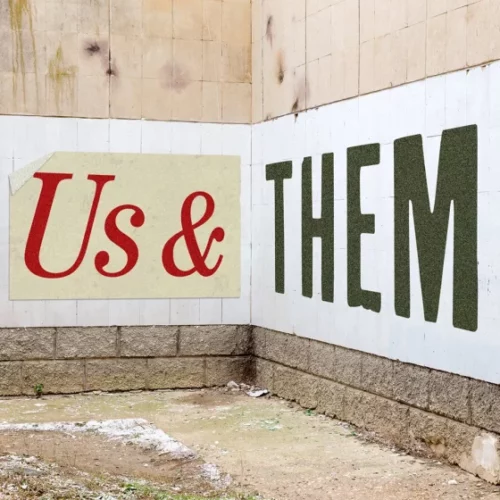It took me a second to find Hector Saldivar’s Lenoir City artists’ studio, but after seeing it, it couldn’t have been any other building. Surrounded by fairly average mid century homes, Saldivar’s building is painted brightly in red, festooned in hanging tropical plants and wind chimes.
Inside, two life-size sculptures rest a table by the doorway. The interior is shady and lined with leafy, tropical plants. Hector and his niece Ariel work intently at a table, dipping strips of paper in papier-mâché by the light of a single lamp. Their extended family surrounds them, some watching, others playing phone games or texting. Snacks are out at another table to the side including tortilla chips and guacamole, food that is easy to eat while they work.
When Saldivar moved to east Tennessee from Mexico City, he didn’t think of himself as an artist. Today, his work in clay, papier mache, and tile shows at galleries all over the region. Over the years, he’s found a way to bring Mexican folk arts to Appalachia. Now, he teaches them, too.
One of the first sculptures he shows me is a little fantasy creature made of papier mache. It’s bright yellow and speckled with green, sort of like a lizard and a dinosaur. Each one is different. Some are cats, some are dogs. Many have wings. Some are blue, red or green. The creatures are called alebrijes.
“This something traditional from Oaxaca, Mexico,” Saldivar says. “They’re made with a special wood in Oaxaca.”
We don’t have that wood in the states, so Hector uses his own materials.
“My alebrijes are made with papier-mâché,” Saldivar says. “I started with wire and tape and later used paper mache, like I’m using right now.”
Hector showed me around his studio, pointing out sculptures on tables, on shelves, bursting out of every corner. As he did so, he told his life story.
“I was originally from Mexico City,” Saldivar says. “And I’ve been here in the United States while living in Knoxville for almost, maybe 35 years. And I’ve been doing art, like maybe 13 years, 14 years.”
But Saldivar always worked with his hands, even before he considered himself an artist. For years before his move, he was making piñatas for festivals in Mexico City.
“I always enjoyed making piñatas,” Saldivar said.
Saldivar was especially busy around Christmastime, during the festival of Las Posadas. It is a nine-day festival around Christmas which combines ancient indigenous practices with Catholic ones. All week people sing carols and break open star-shaped piñatas .
“You have to make one piñata each day,” Saldivar said. “They celebrate the Virgin Mary when she was pregnant. And she was knocking on the doors.”
During Las Posadas, revelers go from door to door, knocking and asking for sweets.
Saldivar’s family, too, had to go knocking on some doors.
Like many other immigrants, they were looking for the surest foothold in the economy they could find. In this case it was restaurant work. They opened a restaurant, the second in Lenoir city. It had to close a few years later, but they held onto the building.
“The building was empty, but I was working with paper mache downstairs,” Saldivar says. “And my sister said, you know, why not put your studio upstairs?”
Over the years, Saldivar met and learned from other artists who encouraged him to explore other mediums, like his clay, papier-mâché, and tile, using his past of piñata-making as inspiration.
In Mexico, papier mache is an old tradition, called cartoneria. It originated with indigenous crafts involving leaves and plant fibers. As indigenous peoples were forcibly converted to Catholicism, paper crafts persisted – often within the framework of Catholicism. That’s why piñatas are still popular around Christmastime. Cartoneria often mixes the sacred and the profane; past artists have made papier-mâché Judases, but also piñatas shaped like members of heavy metal band Judas Priest. The playful cartoneria spirit holds true for Saldivar.
Like Saldivar’s work, crafts were often made from found materials, like newspapers and cardboard. He had some mentors, but also did a lot of self-teaching.
“You know, when I see people doing something, I can try to do it too,” Saldivar says.
Back when Saldivar started, he had trouble getting community interest in his work. People were curious, but kind of confused.
“They said oh, it’s kinda scary, my skulls,” he admitted. “But people now, is getting more interested in Latin culture.”
Saldivar attributes the growing popularity of Mexican folk art to an unexpected source – the Disney movie “Coco.” It focused on the Day of the Dead. Skeletons in dresses are a fixture of Day of the Dead, a Mexican holiday in November that invokes a sense of familiarity and humor about death with visits to family graves, bright colors, and dancing. One such character is Catrina, one of the more bedazzled skull figures of Mexican folk art.
The studio is full of Catrinas in all shapes and sizes, from life-size to the size of a child’s doll. They all grin with an unmistakeable decorated death’s head, adorned in wide-brimmed black hats and well-bustled floor-length gowns.
Saldivar tells me the history of the Catrina. The character was first sketched by the artist Guadalupe Posada to make fun of Mexico City high society, and remind them that La Muerte (Death) would come for them too.
“That’s why she’s dressed, you know, very elegant,” Saldivar says.
Catrina became an iconic figure, and people began to dress like her, make figurines of her. Now, she’s a folk tradition.
We walk past a collection of other art projects.There are little clay Catrinas, a white sculpture with a silver crown, a skull with a spiky surgical mask, representing COVID-19, lay replicas of the Tree of Life, a traditional representation of the Garden of Eden, and Paintings of the Mexican artist Frida Kahlo.
Saldivar returns to the table, where his niece Ariel is working hard at a papier-mache sculpture. Hector’s been making one too. She’s learning from him. Saldivarr’s recently taken on Ariel as an apprentice, thanks to support from the Tennessee Arts Commission.
“Right now, I’m making a heart out of newspaper,” Ariel says, lifting up her work into the light. Behind her, her cousins play video games on their phones, and Saldivar’s sister quietly listens to the conversation.
“Recycled material, two hearts with wire around,” Saldivar adds, with a hint of a proud smile.
Ariel was born right in east Tennessee. She says the apprenticeship has helped her reconnect with her heritage.
“I think it’s more like introducing like the Mexican culture to here,” Ariel says, when asked what this work means to her. “To make Appalachians more diverse and knowledgeable about Mexican culture.”
Lenoir city has changed a lot since Saldivar’s family founded the town’s second Mexican restaurant, but there’s still plenty of work to do.
Saldivar’s work looks colorful and playful, but it has serious cultural connections. I ask him and Ariel if art with deep and resonant meaning might be taken too lightly by some of the gallery viewers who don’t have cultural context for the images. They both respond that that’s what they like best; seeing how its meaning changes in the eyes of the beholder.
“The main thing about doing artwork with my uncle is you can see, like, the different ways that art can be perceived,” Ariel says, not taking her eyes off her work. “Like how subjective it actually is, because my uncle creates different meanings for them, but other people can see them as one way.”
Ariel has presented her work at galleries with her uncle, and hopes to continue to do so in the future. Both want to see their work shown regionally, and Saldivar says he hopes to help create networks of support for other immigrant artists.
As I leave I stop by the ice cream store on the corner – they sell fruit popsicles, in the style of the Mexican state of Michoacan. The sound of children talking and laughing fills the air. The popsicles taste like home, not mine, but I can tell they taste like home to somebody.
























